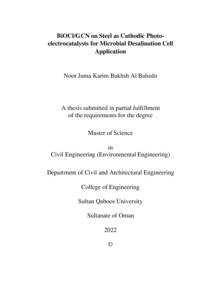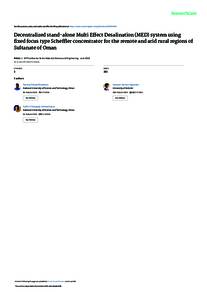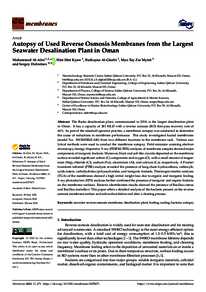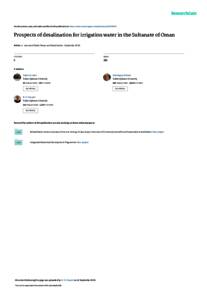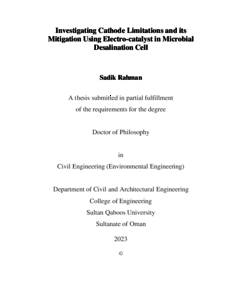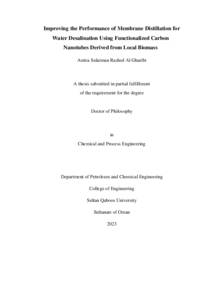Document
BiOCl/GCN on steel as cathodic photo electrocatalysts for microbial desalination cell application.
Other titles
اوكسي كلوريد البسموث\ نيتريد الكربون الجرافيتي )GCN/BiOCl ) على الفولاذ كمحفزات ضوئية كاثودية لتطبيقات خلايا المياه الحيوية الكهروكيميائية
Publisher
Sultan Qaboos University.
Gregorian
2022
Language
English
Subject
English abstract
Microbial Desalination Cell (MDC) is a promising bio-electrochemical system (BES)
for desalination while treating wastewater with minimal energy consumption.
However, the poor performance due to cathodic limitation hinders their large-scale
application. The cathodic reduction reaction is an electrochemical surface
phenomenon; thereby, the cathode's surface charge transfer and thermodynamic
efficiency are crucial for reaction kinetics. To improve the cathodic reaction kinetics,
the study investigated on Bismuth oxychloride (BiOCl), which is an earth-abundant,
nontoxic, anti-corrosive light-responsive electro-catalyst hybridized with a very
promising graphitic-C3N4 (GCN), a graphene-like electronic structured catalyst coated
on stainless steel mesh (SSM) support for MDC cathode. Several photo electrocatalysts of BiOCl/GCN were prepared from different compositions of BiOCl
to GCN. All the combinations of the prepared photo-electrocatalysts were
characterized to understand surface morphology via FTIR, XRD, and Photo
luminance-spectroscopy (PL-spectra) and for electrochemical activity via cyclic
voltammetry (CV). FTIR and XRD spectroscopies confirm the successful synthesis of
the BiOCl/GCN composites by adhering to distinct properties of BiOCl and GCN. PL spectra analysis revealed the effectiveness of BiOCl/GCN composites in reducing the
recombination effect of photocarriers in comparison to the blank BiOCl and GCN. To
understand the electrochemical performance of BiOCl/GCN composites with/without
activated carbon, CV analyses with different loading rates (i.e., 20, 30, and 50 mg/cm2
)
were performed in the presence/absence of light. The 40 mg/cm2
loaded and AC
supported heterojunctions exhibited higher redox current densities, revealing the
effectiveness of AC as conductive support material. BiOCl/GCN (100:0 wt.%),
BiOCl/GCN (75:25 wt.%) & BiOCl/GCN (25:75 wt.%) were the best three performing
hybrids. However, the catalysts performed similarly in the absence and presence of
light. These results contrast with the morphological analysis that confirmed the
photocatalytic structure of BiOCl/GCN. These findings may be attributed to the type
of light source, which demands further characterization studies. The research will
eventually aid in understanding the potential applications of such promising
composites for advanced electrochemical applications, including renewable energy
recovery, electrochemical desalination, photovoltaic energy, and much more.
Member of
Resource URL
Arabic abstract
تعد خلايا تحلية المياه الحيوية (MDC (نظاما بيولوجيا كهروكيميائيا (BES (لتحلية المياه اثناء معالجة مياه الصرف الصحي باستهلاك اقل للطاقة. ومع ذلك ، فان الاداء الضعيف المتعلق بالقيود الكاثودية يعيق من تطبيقها على نطاق اوسع. تفاعل الاختزال الكاثودي هو ظاهرة كهروكيميائية سطحية حيث يعد نقل الشحنة بالغ الاهمية في حركية التفاعل. لذلك قد اقترحت هذه السطحية والكفاءة الديناميكية الحرارية لسطح الكاثود امراً كمحفزاً كهربائياً ، غير سام ، مضاد للتآكل ، و مستجيباً الدراسة مركبات اوكسي كلورايد البسموث )BiOCl ) للضوء والمهجن مع نيتريد الكربون الجرافيتي )(4N3C-g (GCN (وهو محففز و منظم الكتروني يشبه الجرافين ويغطي شبكة من الفوالذ المقوام للصداء )SSM )التي تعمل كداعم لكاثود الخلية الحيوية الكهروكيميائية. تم تحضير محفزات نهائية مختلفة لـ )GCN/BiOCl )عن طريق تغيير نسبتها. تم وصف التركيبة المحضرة عبر مطياف الاشعة تحت الحمراء ) FTIR )ومقاس حيود الاشعة السينية (XRD (والتحليل الطيفي معان ضوئي (PL (و كهروكيميائيا عند طريق تحليل الفولتميتر الدوري (CV(. تماشياً مع الدراسات الاخرى ، تؤكد نتائج التحليل الطيفي )FTIR )و (XRD (على عملية التوليف الناجحة لمركبات )GCN/BiOCl )من خالل التمسك بالخصائص المميزة لكال من )BiOCl )و)GCN). وقد كشف التحليل الطيفي معان ضوئي (Spectra-PL ( على فعالية مركبات )GCN/BiOCl )في تقليل تاثير اعادة تركيب الحامالت الضوئية بالمقارنة مع BiOCl وGCN النقيان. وفي سبيل فهم الاداء الكهروكميائي لمركبات )GCN/BiOCl )اما مدعومة\ غير مدعومة بالكربون المنشط ، تم اجراء تحليل الفولتميتر الدوري بمعدالت تحميل مختلفة للكاثود ) ۲۰ - ۳۰ - ٤۰ – ٥۰ مج\سم 2 2 ( في ظل وجود وغياب الضوء. أظهرت المحفزات الهجينة ذات التحميل ال ٤۰ مج \سم والمدعومة بالكربون النشط نتائج عالية في كثافات التيار الكهربائي الناتج من عمليات الاكسدة والاختزال ، مما يثبت فعالية الكربون النشط كمادة موصلة لدعم المحفزات. قد سجلت )(BiOCl of .wt 100%(GCN/BiOCl )و انواع كافضل( BiOCl/GCN(25% wt. of BiOCl)( و( BiOCl/GCN(75% wt. of BiOCl)( المحفزات الهجينة التي اوضحت عن نتائج عالية من التيارالكهربائي عن مقارنتها بغيرها. ومع ذلك فان جميع المحفزات الهجينة قد اوضحت عن نتائج مشابهه في ظل غياب وحضور الضوء مما يتعارض مع النتائج الطيفية التي اكدت على البنية الكهروضوئية لمحفزات )GCN/BiOCl). قد تعزى هذه النتائج الى نوع مصدر الضوء الذي يتطلب المزيد من دراسات التوصيف ل )GCN/BiOCl )مثل التحليل الضوئي لألشعة المرئية والفوق . نهايةً بنفسجية )Spectroscopy Vis-UV )، سيساعد هذا البحث في فهم التطبيقات المحتملة لهذه المركبات الواعدة لالنظمة الكهروكيميائية المتقدمة مثل ابحاث الطاقة وتحلية المياه وغير ذلك.
Category
Theses and Dissertations

